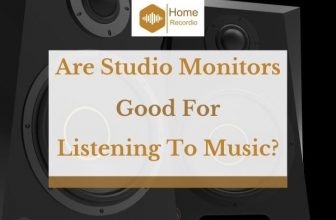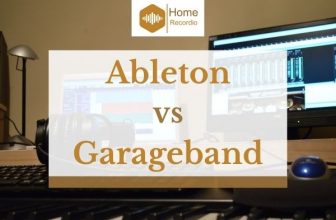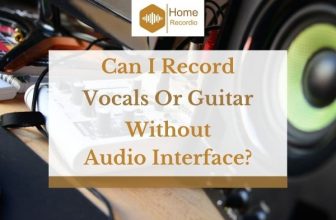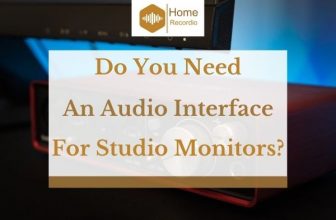7 Best Studio Monitors Under 1000 Dollars
For musicians, sound engineers and audio specialist, having the right equipment is key. You need equipment that will accurately reproduce the sound you want, without reverberation or coloration. You need this equipment to be reliable, powerful and capable of producing high-quality audio without errors.
Usually one of the most important pieces of kit for any aspiring studio owner is a studio monitor. This is a bulky near-field loudspeaker which is designed to accurately reproduce the supplied audio, in a linear phase manner, with no notable emphasizing or de-emphasizing of certain features.
Unfortunately, a typical, high-quality studio monitor does not come cheap. Accurate sound reproduction combined with build quality and brand names can often push the price up into the thousands. While this might not be an issue for famous rock artists or big-name record companies, this price can be prohibitive for smaller independent artists or music labels.
So, the quest of finding the best studio monitors under 1000 dollars is extremely relevant for up and coming artists, and music lovers in general.
In this comprehensive article, we review some of the best, affordable studio monitors on the market right now. Each one has its own peculiar advantages and disadvantages, and the reviews should help you decide which monitor would most closely suit your requirements.
Right now, finding a good studio monitor for under $1000 may seem like an impossible task, but rest assured it is possible!
[amazon table=”4863″]Table of Contents
Adam Audio A7X Powered Studio Monitor
[amazon box=”B003SYYU9C”]Great technology is the end result of numerous iterations and revisions, with every technician and engineer trying to improve on past work. That is exactly what has brought this product to the market. It is a great improvement in almost every way from the A7 studio monitor which preceded it, and it is a testament to the ingenuity and innovation of the engineers.
One of the major advantages of this model is the large frequency range it covers. This is essential for accurate sound reproduction, so no matter what you’re using this studio monitor, you will benefit from this.
The extension of the frequency range is mainly due to the redesigned ‘tweeter’ which is the speaker dedicated to the higher frequency sounds. This tweeter can now produce sounds up to 50 kHz, which is far above the threshold of hearing for most people.
There is lots of fancy technology working away in the background of this product. For instance, the X-ART tweeter is designed to enhance the sound pressure response and guarantee accurate sound production at all frequency and decibel levels.
The build quality of this device cannot be doubted, with a simple matt black finish and a top of the range carbon fiber driver. The mid-woofer and tweeter work seamlessly together for whatever sound reproduction needs you have, and the monitor can handle 100 Watts of power.
Each driver has its own dedicated amp, leading to better sound quality as well as some built-in redundancy.
- Large Frequency Range (up to 50 KHz)
- Builds and improves on a very successful pre-existing design
- Each driver has a powerful, dedicated amplifier
- Only contains a mid-woofer and tweeter, a sub-woofer may be required to accurately capture the lowest tones.
Check Price and Reviews on Amazon
Video: “Adam Audio A7X Review – Should You Buy Them?”
Yamaha HS5 Powered Studio Monitor Pair (Bundle with two monitors)
[amazon box=”B01DB0JSMG”]This package includes a stereo sonic pair of monitors. This innovation has existed for a long time and is proven to help recreate the way we experience sounds naturally, by hearing the sound through both ears. For best results you should be located roughly equidistant from the two monitors.
Beyond just coming in a pair, this product has a lot of advantages going for it.
Firstly, this is a bi-amp design, which means that the two speakers can be powered by either of the tow on-board amplifiers. This allows for more flexibility and a clear sonic experience. There is also a decent level of power built into this model, although not so much as some more premium products.
What you will get is pure honest, unaltered sound. This is extremely important in a studio environment because the sound you mix or record should be perfect, since it will eventually be laid on inferior playback devices such as phone and computer speakers.
To help reduce unwanted flux and distortion, the circuitry in this device is quite complicated and utilizes advanced magnetic circuit design. This can help smooth out transients and leads to a more realistic final sound.
What’s more, this monitor has a wide array of ports and jacks that will take virtually any signal input.
- Bi-Amp design
- Advanced magnetic circuitry helps reduce distortion
- The two monitors come in this one package
- The high frequency amplifier is relatively weak (25 W), which reduces headroom for peak sounds.
- Only contains a mid-woofer and tweeter, a sub-woofer may be required to accurately capture the lowest tones.
Check Price and Reviews on Amazon
Video: “Studio Monitor Speaker Review: Yamaha HS5”
Neumann KH 120 A – Active Studio Monitor
[amazon box=”B004OA84DM”]Like most of the other devices on this list of the best studio monitors under 1000 dollars this is an active device.
What this means is that all the components, such as amplifiers and crossovers, are integrated into the device. This sets them apart from passive devices, which have a modular design requiring you to purchase and connect the amps and crossovers separately.
For most purposes, active systems are more than adequate (since the internal components are well-matched by skilled acoustic engineers) and are a lot more convenient.
This is definitely true of the Neumann KH 120 A. This device might not offer the widest frequency range, but what it does provided is unrivalled design quality.
For example, the casing is made from polished aluminum that reduces any resonance-induced coloration of the outputted sound. Also, the 1-inch tweeter speaker is made from a titanium alloy that is sure to provide accurate high-frequency tones. This is also bi-amplified, with two internal 50 W amps. This is more than enough to give you adequate volume and range.
The design of this is classy but also a bit different, with the brushed metal really reflecting the light. There’s also some complicated math going on behind the scenes to make sure you get the best audio experience possible.
There is a mathematically modelled dispersion waveguide (mmd) which helps to deliver a smooth sound at all times, while the there is lots of controls for you to play with to optimize the delivery of the sound. You can correct for the input gain, output gain and a host of other options.
- Bi-Amp design
- Aluminum casing helps reduce resonance and allows for efficient heat dissipation
- Offers you a lot of flexibility to adjust the sound
- Limited range (up to 21 kHz)
- Premium product with a premium price tag
Check Price and Reviews on Amazon
Video: “Neumann KH 120A Studio Monitor User Review”
Mackie HR624mk2 6-inch 2-Way Studio Monitor (Single Speaker)
[amazon box=”B003552MEY”]This is another technical triumph which is well deserving of a place on the definitive list of best studio monitors under 1000 dollars. Like other products, it builds on the successes of previous generations of studio monitors.
This monitor provides ultra-linear frequency response at all ends of the spectrum. For example, at the lower end of the spectrum it has a high-quality, optimized 6.7-inch low frequency transducer which minimizes distortion.
This quality extends to the upper ranges of hearing as well, with the tweeter provider clean and crisp sounds right up to the limits of hearing.
The titanium dome is strong and durable, but also flexible enough to hit all the notes and cut out any unwanted distortion. This is also an active studio monitor, which means you don’t have to worry about finding suitable amplifiers or other equipment to pair it with.
Everything you need is included here and is ready to use straight out of the box. You can combine this model with a sub-woofer from the same company and the same series, but this is not necessary for most purposes, because this monitor provides plenty of low-frequency power.
This is a very versatile studio monitor that is perfect if you need to mix music, record, or produce professional quality soundtracks for movies or TV. This monitor can really do it all, and for under 1000 bucks, which is sometimes hard to come by!
- 6.7-inch titanium low frequency speaker gives great bass note production
- Accurate, ultra-linear frequency response
- Has an optimized wave guide for a wide sweet-zone, potentially allowing multiple people to enjoy the superior audio experience
- Active studio monitor
- Sold as a single monitor, you may want to buy a pair to get the best experience
- Basic, black design
Check Price and Reviews on Amazon
Focal 2x Alpha 65 6.5″ Active 2-Way Near Field Professional Monitoring Speaker
[amazon box=”B00LI6S7FA”]This is another one of the best studio monitors under 1000 dollars. This does exactly what you want a professional grade studio monitor to do. It produces accurate sound with minimum flair or distortion, so that you can accurately rate, mix or critique the quality of the sound.
Because of the stereophonic design of this speaker pair, this model also minimizes directivity, so you should have the same aural experience anywhere in the room.
This can be connected to audio sources via either XLR or RCA. This monitor set also keeps good tonal balances at all volume ranges, so no matter whether you’re quietly listening to a soft acoustic song, or rocking out to a heavy-metal ballad, you should have a great listening experience regardless.
With 105 W of amplification power, those volumes can be quite impressive!
- Accurate, ultra-linear frequency response
- Has an optimized sweet-zone, potentially allowing multiple people to enjoy the superior audio experience
- Comes as a stereophonic pair
- Active studio monitor
- Limited upper frequency range
- Basic, black design
Check Price and Reviews on Amazon
Video: “Focal Alpha 65 (Studio Monitor) Review”
Pioneer Pro DJ Studio Monitor RM-07
[amazon box=”B013NJZ4LE”]The best studio monitors under 1000 dollars generally have a similar design and appearance, but occasionally they have one or two unique features that help to set them apart. This is certainly the case with the Pioneer Pro DJ monitor.
Unlike in the other models, in this DJ-focused studio monitor, the tweeter and woofer are actually connected co-axially, meaning that the upper and lower tones all emanate from the same place. This improves the overall audio experience and makes for a more natural listening environment.
This is complemented by a redesigned waveguide which limits any destructive interference from the two co-located drivers.
The tweeter is one of the real high-points in this design. The intricate, 1.5-inch aluminum shell allows you to produce clear and crisp tones up to 50 kHz, which is actually far higher than you will require for most purposes.
Another major advantage is that this speaker has in-built EQ function. This means you can vary some settings to optimize for the room you are in. The tight bass response and the very wide frequency range are all indicators that this is a very premium product.
- Wide frequency range, from just 40 Hz to 50 kHz
- Bi-Amp, two-way speaker
- Co-Axial tweeter and woofer design to minimize distortion
- Active studio monitor
- Very premium product with a matching price point
- Sold as a single monitor
Check Price and Reviews on Amazon
Video: “Pioneer RM-07 Active Monitors Review”
KRK Rokit Powered 10-3 Pair Mid-Field 3-Way Powered Studio Monitors
[amazon box=”B005P0UHA8″]For the best studio monitors under 1000 dollars, you probably expect something a bit special. Well this kit from Rokit probably fits into that category. That’s because, unlike the other products featured on this, this product has a true 3-way design.
This means that as well as having a tweeter and a woofer for the upper and lower tonal ranges respectively, it also includes a separate speaker to deal with mid-range frequencies. This helps to optimize the outputted sound, because certain sizes of speakers are better suited to specific frequencies.
The baffle between the high and mid frequency speakers is a genius innovation which virtually eliminates all the distortion due to diffraction between these two sound sources.
Additionally, this is a mid-field monitor which is perfect for home studios or small playback areas. For optimum listening, you should be within 1-4 meters of the studio monitors.
- 3-way speaker
- Deals extremely well with mid-range frequencies
- Contains multiple amps
- Active studio monitor
- Bright Yellow speaker design can be off-putting
- Not optimized for extremely low frequencies
Check Price and Reviews on Amazon
Video: “KRK Rokit 10-3 G3 Talkthrough Video”
What To Look For In The Best Studio Monitors Under 1000 Dollars?
If you’re going to invest your hard-earned money on a professional grade studio set up, complete with high performing studio monitors, then it’s important to do your research beforehand. It is vital that you understand what are the features that are most valuable.
It also helps to learn some of the terminology that goes along with this kind of high-level technology. This will also help you to weed through the spin in the fancy marketing and seek out the actual truth that lies behind the prose.
Every company will use slightly different terms to describe their monitors, but there are a few common specs and features for you to look out for.
Active or Passive
Video: “ACTIVE Speakers vs PASSIVE Speakers || Which is Right For You??”
One of the first, fundamental choices you have to make is whether to go for an active or a passive system. All of the studio monitors featured on this list have been active systems, and there is a very good reason for that. Active systems contain all the required hardware already integrated into the speaker body.
On the other hand, passive systems are modular in nature, so you will have to buy and install the various amplifiers, crossovers, and any other components individually. Not only is this potentially difficult for a novice, but purchasing these components separately means the total price can quickly rise to over $1000.
For convenience and ease of installation, active systems can’t be beat. Plus, when buying an active system, you can be fully confidant that the amplifiers and crossovers are compatible with the drivers. Unless you are very technically confidant, it can be hard to make this assessment when designing passive systems.
POWER!
Power is often considered to be one of the most important factors to look at when buying a new studio monitor. And this is true, but maybe not for the reasons you would think. Most people might equate power, with the total volume of the system. This is only part of the story.
High power is definitely required to reach ear-piercing volumes, but it can also be important even when playing sounds at a normal volume. This is because ‘peak sounds’ in music can demand much more power than the time-averaged demand from the music.
This could include the snare drum hits in a song for example. Often this peak power can be 10 times as much as the average power.
So, having high power amplifiers gives you ‘headroom’. This ensures that even these occasional sounds come out undistorted and are accurately represented. Without high power capabilities, these peak sounds could be ‘cut off’, leading to an uneven, fragmented listening experience.
Ideally you should have separate high-power amplifiers for both the higher and lower frequencies. Over 100 Watts of power is considered good among these kinds of studio monitors.
Multiple Amps
People are often confused by the terms single amp and bi-amp (or tri-amp). They do not refer to the number of speakers the monitor has. Instead, they refer to how many amplifiers there are in the monitor, and how the signal is processed before it arrives at the drivers (which make the sound you hear).
In a bi amp configuration, the signal is divided up by the crossover network before it is sent to the individual amps for high and low frequencies. This gives a flatter response, and a more accurate representation of the signal in general.
So, it is worth paying extra for a bi-amp or tri-amp studio monitor, compared to a single-amp model.
Tweeters and Woofers
Video: “Subwoofers, Woofers, and Tweeters as Fast As Possible”
Tweeters are the speakers (i.e. drivers) that produce the high-pitched notes and the woofers produce all the lower bass notes. You should make sure that these are high-quality, producing minimal reverb, and that they don’t cause excessive interference with each other.
One thing to look for is the overall frequency range. If you really want all the high notes to be included, then you should look for models whose range extends up to 50 kHz.
If you are more concerned with the bass notes, and you don’t want to invest in a separate sub-woofer, then choose a model which can produce tones as low as 40 Hz.
Some models also include a third driver which focuses on producing the mid-range notes. This can give an even better linear response, but often comes with an additional cost factor.
Other Factors
There are a few other features that you might look for in a high-end model. For example, some models give you an ability to adjust the settings to correct for the acoustics in the room.
These are often called ‘equalization’ or simply ‘EQ’ controls. They essentially help to ‘tune’ your monitor to its environment, to ensure accurate sound reproduction at all times.
When buying a studio monitor, make sure you take into account the cost of ancillary equipment that you need to go along with the monitor. For example, you might want to invest in stands for the speakers, or you may require different cables or transformers.
[amazon table=”4863″]Conclusion
Studio monitors are on a whole different level to commercial speakers, hence the dramatic difference in price. But just because you appreciate music production doesn’t mean you should need to break the bank. That’s why we’ve compiled this list of the best studio monitors under 1000 dollars.
Studio monitors are designed to accurately reproduce the input signals as closely as possible, without any coloration or distortion. They demand an ultra-linear frequency response, which in turn requires a lot of fancy circuitry and mechanical wizardry.
But just because this sounds very technical doesn’t mean you need to feel out of your depth when making a purchase. Look for simple things like the overall power rating, the type of amplifier configuration, the frequency range, and the number of drivers.
If you follow these simple steps, you should be confidant about getting a good deal on a studio monitor.




